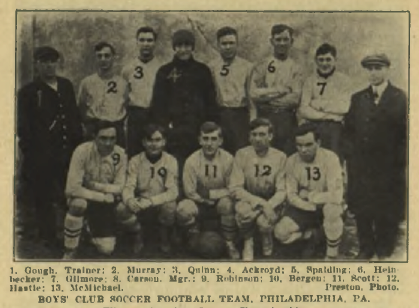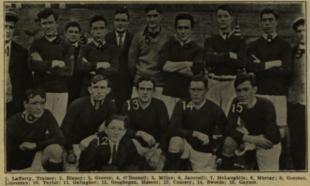Featured image: 1912-1913 Philadelphia Hibernians
2013 is the centennial of the US Soccer Federation. Our series looking back at the Philadelphia soccer scene one hundred years ago continues.
There was plenty for the Philadelphia soccer community to talk about one hundred years ago this week. Along with games in the three divisions of the city’s Allied American League and two divisions of the Cricket League, there were fixtures in the Philadelphia Junior League, exhibition games, as well as the debut of the new United League. But the big games of the weekend were two games in the Philadelphia Challenge Cup tournament.
 League play
League play
Big scores were the theme in the Allied American League first division matches on Jan. 18, 1913. Even though there were only three games on the schedule, the victors won by a collective total of 24 goals to 4. West Philadelphia piled it on Reading, winning 8–4 while Cardington topped Peabody 4–1. But the biggest tally was Bethlehem’s 12–0 thumping of Falls FC. The Inquirer reported on Jan. 19, “The game was played on a very muddy field in a rainstorm. The visitors played pluckily, but the locals could not be denied.” Future National Soccer Hall of Famer Tommy Fleming scored five of Bethlehem’s goals in the win, the club’s thirteenth straight win of the season.
The weekend’s Allied League second division games featured a number of teams from outside of the city, with Wilmington’s Irish Americans defeating the Viscoes of Marcus Hook, and Darby YMA defeating Wilmington’s Windsor team on the road thanks to two own goals from the home side.
In the third division, Hibernian Juniors traveled to the Fairhill Wanderers home ground at 22nd ant Huntington streets only to suffer “a severe drubbing,” losing 16–0. Meanwhile, despite the fact that they had only nine players on the pitch, St. Nathaniel defeated Cheltenham 2–0.
In first division play in the Cricket Club League, Germantown easily defeated Merion 4–0 while University of Pennsylvania defeated Philadelphia Cricket Club 2–1. The Inquirer said of Penn’s victory on Jan. 19, “On the merits of the play of both teams a draw would have been a better decision. It was an even game but none of the goals scored were good ones, all being more or less lucky.”
The city’s Pennsylvania League had no games scheduled for the weekend due to the Philadelphia Challenge Cup fixtures. The only scheduled American League game between P & R AA and Philadelphia Electrics was postponed due to former club’s “grounds not being in proper shape.”
United League debut
Philadelphia’s newest amateur league, the United League, debuted on Jan. 18, 1913 with six matches featuring church, social club, and company-based amateur teams from in and around the city. The Inquirer reported on Jan. 20, “Judging by the splendid showing of the majority of the teams in the United League, which made its initial bow to the soccer public last Saturday, there is every reason for believing that it will have a successful season. In nearly every game play was of an interesting nature and one of the most outstanding features was the manner in which the boys played the game in the proper spirit, which incidentally made it an easy task for the referees to discharge their duties to the satisfaction of all concerned.”
Philadelphia Challenge Cup
 Anticipation was high for the second round Philadelphia Challenge Cup matchup at Second and Allegheny between Pennsylvania League leaders Hibernian and American League leaders Boys’ Club on Jan. 18, 1913. The Inquirer expected “one of the fastest soccer matches of the season.” On a wind swept pitch, what played out instead was what the Inquirer match report described on Jan. 19 as a game “of the regular cup tie order where both teams battled every inch of ground.”
Anticipation was high for the second round Philadelphia Challenge Cup matchup at Second and Allegheny between Pennsylvania League leaders Hibernian and American League leaders Boys’ Club on Jan. 18, 1913. The Inquirer expected “one of the fastest soccer matches of the season.” On a wind swept pitch, what played out instead was what the Inquirer match report described on Jan. 19 as a game “of the regular cup tie order where both teams battled every inch of ground.”
The Inquirer reported that the Hibs “must have left their shooting boots in the dressing room for they had at least three chances of netting the ball” in the first half. Still the Pennsylvania League leaders were up 1–0 after 25 minutes of play when the Boys’ Club goalkeeper misjudged a headed ball.
The Hibernians’ greater experience began to tell while the Boys’ Club defenders “resorted too often to booting the ball without in the least trying to place it to their forwards, while they also too often tried to play the man instead of the ball, and their display was marred in consequence.”
In the second half, Boys’ Club were handed a lifeline when the Hibs’ Tommy Swords, a future National Soccer Hall of Famer, was sent off for a dangerous tackle. They dodged another bullet when Hibernian missed a penalty kick that was awarded after Dick Spalding, another future Hall of Famer, handled the ball. Nevertheless, the Boys’ Club offense couldn’t break their opponent’s more experienced backline and the game ended in a 1–0 win for the Hibs.
Swords and Spalding would later play together on the team that represented the United States in the 1916 tour of Scandinavia. In 1927, Spalding signed as an outfielder for the Philadelphia Phillies, returning to the team as a first base coach in 1934.
The weekend featured another Philadelphia Challenge Cup, this time between the Athletics and Camden at Fairhill Ball Park at Third and Lehigh. Four points separated the fifth place Athletics from sixth place Camden in the American League but on the day, Camden quickly proved the superior team. Five minutes after the opening whistle, Camden scored their first goal. They scored a second two minutes later. A penalty kick soon saw them up 3–0. By the time the halftime whistle was blown, Camden was winning 5–0.
While the Athletics were able to save some face with a consolation goal in the second half, they saved their real fight for after the game. On Jan. 23 they lodged a protest with the Philadelphia Challenge Cup committee claiming that Camden had fielded two players who were not registered to play for them in the Cup tourney.
Promising goalkeeper dies
On Jan. 22, 1913, a notice appeared in the Inquirer’s obituary section inviting members of the “Pennsylvania League and Allied Amateur Soccer Football Association” to the funeral of John Paul Kelly, who lived at Seventh and Allegheny at 3157 Sheridan Street. Two days later, a short memorial article appeared in the sports pages of the Inquirer under the headline, “John Kelly Dead: Great Soccer Goalkeeper Called By Grim Reeper.”
The article described a career that included time with the Vespers of the city’s old Amateur League as well as with Thistle of the Pennsylvania League “where he was always the backbone of the team between the posts.” Kelly was good enough to attract the attention of scouts from abroad. The Inquirer says, “Kelly was given big inducements two years ago to play for one of the senior teams in Ireland, but after playing a few games he proved to be too light, and that alone proved a handicap to him in not getting a berth as a first division player.”
Returning to Philadelphia, Kelly played for Philadelphia Celtics and then Tacony. “Kelley tried to come back at the beginning of this season,” reported the Inquirer, “and after keeping goal for Tennyson in the Pennsylvania League, he had to leave the field at halftime, which was the last time he played.”
Succumbing to a “long and severe sickness,” Kelly passed away at his home. He was 25 years old.


Comments